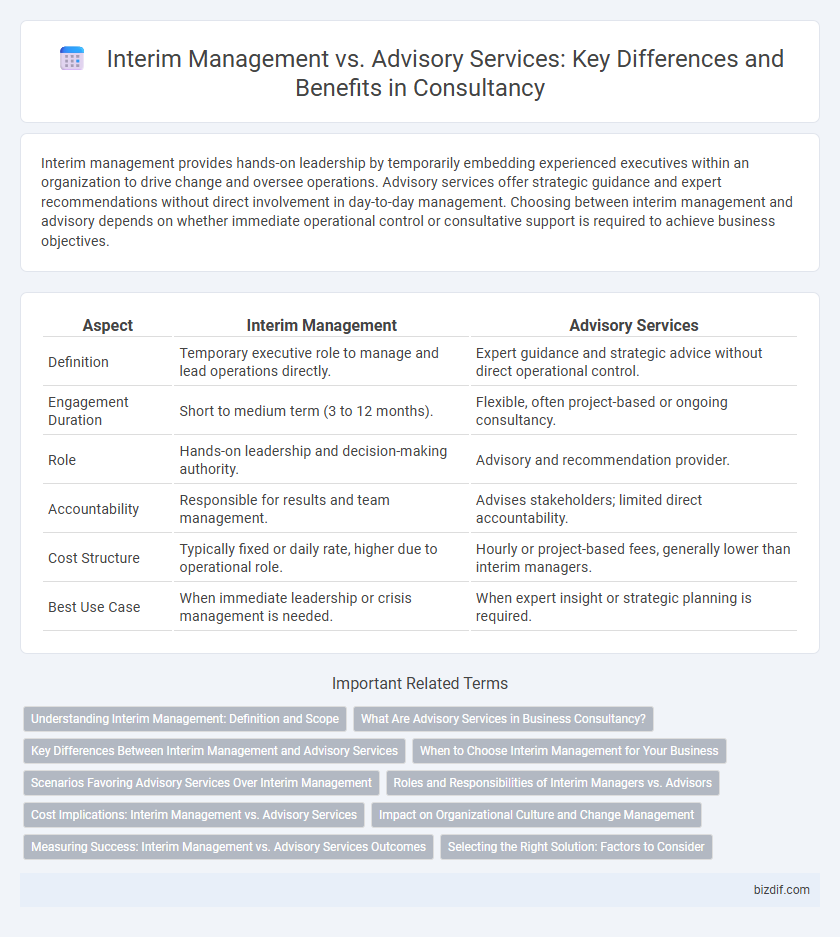Interim management provides hands-on leadership by temporarily embedding experienced executives within an organization to drive change and oversee operations. Advisory services offer strategic guidance and expert recommendations without direct involvement in day-to-day management. Choosing between interim management and advisory depends on whether immediate operational control or consultative support is required to achieve business objectives.
Table of Comparison
| Aspect | Interim Management | Advisory Services |
|---|---|---|
| Definition | Temporary executive role to manage and lead operations directly. | Expert guidance and strategic advice without direct operational control. |
| Engagement Duration | Short to medium term (3 to 12 months). | Flexible, often project-based or ongoing consultancy. |
| Role | Hands-on leadership and decision-making authority. | Advisory and recommendation provider. |
| Accountability | Responsible for results and team management. | Advises stakeholders; limited direct accountability. |
| Cost Structure | Typically fixed or daily rate, higher due to operational role. | Hourly or project-based fees, generally lower than interim managers. |
| Best Use Case | When immediate leadership or crisis management is needed. | When expert insight or strategic planning is required. |
Understanding Interim Management: Definition and Scope
Interim management involves temporarily placing experienced executives within an organization to lead change, manage transitions, or fill leadership gaps during critical periods. This approach provides hands-on decision-making authority, enabling rapid implementation of strategic initiatives and operational improvements. Unlike advisory services that offer recommendations and strategic advice, interim managers take direct responsibility for outcomes and resource management.
What Are Advisory Services in Business Consultancy?
Advisory services in business consultancy provide expert guidance to improve organizational performance, focusing on strategic planning, risk management, and operational efficiency. Unlike interim management, which involves taking temporary executive roles to directly manage projects or teams, advisory services emphasize analysis, recommendations, and support without direct operational involvement. These services leverage industry insights and data-driven strategies to help businesses achieve long-term growth and resilience.
Key Differences Between Interim Management and Advisory Services
Interim management involves temporary leadership roles where experts take direct control of an organization's operations to drive change and achieve specific goals. Advisory services provide strategic guidance and recommendations without direct decision-making authority or day-to-day involvement. Key differences include the level of responsibility, with interim managers acting as hands-on executives, while advisors primarily influence through consultancy and expertise sharing.
When to Choose Interim Management for Your Business
Interim management is ideal when businesses face urgent leadership gaps, require specialized expertise for critical projects, or need immediate operational stability during transitions. Choosing interim managers allows companies to drive change rapidly with experienced professionals embedded directly in their organizational structure. This approach ensures hands-on decision-making and accountability, unlike advisory services which primarily offer strategic recommendations without executive authority.
Scenarios Favoring Advisory Services Over Interim Management
Advisory services excel in scenarios requiring strategic guidance without direct operational involvement, such as long-term planning, market analysis, and risk assessment. Organizations prioritizing expert recommendations to inform decision-making or navigate complex regulatory environments benefit more from advisory roles. These services provide specialized insights while allowing internal teams to maintain execution control, unlike interim management which assumes temporary leadership roles.
Roles and Responsibilities of Interim Managers vs. Advisors
Interim Managers assume direct operational control and drive organizational performance during transitional phases, often with full decision-making authority to implement changes swiftly. Advisors provide strategic guidance and expert recommendations without engaging in day-to-day management, focusing on long-term planning and risk mitigation. The responsibility of Interim Managers revolves around execution and accountability, whereas Advisors concentrate on analysis, counsel, and influencing executive decisions.
Cost Implications: Interim Management vs. Advisory Services
Interim management typically incurs higher direct costs due to the executive-level involvement and full-time commitment required during a transitional period, often ranging from $10,000 to $30,000 per month depending on industry and expertise. Advisory services, while generally less expensive with hourly rates between $150 and $500, offer strategic guidance without the overhead of day-to-day management responsibilities. Businesses must weigh these cost implications against their operational needs and budget constraints to determine the most effective approach for their project or organizational challenge.
Impact on Organizational Culture and Change Management
Interim management embeds leadership directly within the organization, driving cultural change through hands-on decision-making and real-time problem solving, which accelerates transformation and employee engagement. Advisory services influence organizational culture indirectly by providing strategic guidance and recommendations that require internal adoption and sustained effort for effective change management. The choice between interim management and advisory services significantly affects how swiftly and deeply organizational culture shifts, with interim managers often enabling faster, more tangible impacts.
Measuring Success: Interim Management vs. Advisory Services Outcomes
Measuring success in interim management is primarily based on achieving specific operational goals within a defined timeframe, such as cost reduction, process optimization, or crisis resolution. Advisory services focus on strategic impact, assessed through long-term business growth, enhanced decision-making frameworks, and sustainable organizational improvements. Key performance indicators (KPIs) for interim management include project completion rates and immediate financial metrics, while advisory success is evaluated through client satisfaction, strategic milestones, and ongoing value creation.
Selecting the Right Solution: Factors to Consider
Selecting the right solution between Interim Management and Advisory Services depends on factors such as the urgency of business challenges, the need for hands-on leadership, and the desired level of strategic input. Interim Management provides temporary executive leadership to drive immediate change, while Advisory Services offer expert guidance to inform long-term decisions without direct operational control. Evaluating the organization's current capacity, project scope, and required speed of implementation ensures alignment with the most effective consultancy approach.
Interim Management vs Advisory Services Infographic

 bizdif.com
bizdif.com